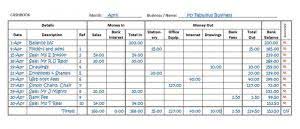
This is defined as the amount of cash from operating activities minus the amount of cash required for capital expenditures. Some people also subtract the corporation’s cash dividends when the dividends are viewed as a necessity. Cash outflows used to repay debt, to retire shares of stock, and/or to pay dividends to stockholders https://www.bookstime.com/ are unfavorable for the corporation’s cash balance. In financial accounting, corporate income can be broken down in a multitude of ways, and firms have some latitude on how and when to recognize and report their earnings. Two such measurements are comprehensive income and other comprehensive income (OCI).
Free Financial Modeling Lessons
B is incorrect because comprehensive income includes not only revenue and expense items that are excluded from the net income calculation (other comprehensive income), but also net income. It provides a comprehensive view for company management and investors of a company’s profitability picture. Like other publicly-traded companies, Ford Motor Company files quarterly and annual reports with the SEC. In its first quarter filing for 2023, it published its consolidated statements of comprehensive income, which combines comprehensive income from all of its activities and subsidiaries (featured below). The difference would be recognized as either a gain or loss in the OCI line item of the balance sheet. Bear in mind that OCI is not the same as comprehensive income, though they certainly sound alike.
Other Comprehensive Income vs. Realized Income
Also known as comprehensive earnings, this is a catch-all classification for the items that cannot be included in typical profit and loss calculations because they do not stem from the company’s regular business activities and operations. Hence, they have to bypass the company’s net income statement—the sum of recognized revenues minus the sum of recognized expenses—which does include changes in owner equity. For large corporations, typical examples might include gains and losses from unmatured bond investments, changes in the company’s pension plan, and fluctuations from foreign currency statement of comprehensive income transactions. Profit or loss includes all items of income or expense (including reclassification adjustments) except those items of income or expense that are recognised in OCI as required or permitted by IFRS standards. Reclassification adjustments are amounts recognised to profit or loss in the current period that were previously recognised in OCI in the current or previous periods. Examples of items recognised in OCI that may be reclassified to profit or loss are foreign currency gains on the disposal of a foreign operation and realised gains or losses on cash flow hedges.
- The interaction between profit or loss and OCI is unclear, especially the notion of reclassification and when or which OCI items should be reclassified.
- Or maybe you’re looking for more than just the once-a-year conversation with your accountant.
- Income excluded from the income statement is reported under “accumulated other comprehensive income” of the shareholders’ equity section.
- It will help you understand the risk-return ratio even before investing in the organization.
- Unrealized income might come from non-owner sources, including gains due to foreign currency transactions, fluctuating asset values, and hedge financial instruments, among other financial events.
Accumulated Other Comprehensive Income: Balance Sheet Example
Other comprehensive income (OCI) is an important component of comprehensive income, but they are not interchangeable. OCI, sometimes referred to as comprehensive earnings, represents specific types of unrealized gains and losses that are not included in a company’s net income. The “Other Comprehensive Income (OCI)” line item is recorded on the shareholders’ equity section of the balance sheet and consists of a company’s unrealized revenues, expenses, gains, and losses.
Currency Exchange
The sum of all the revenues, expenses, gains, and losses to this point represents the income or loss from continuing operations. This is a key component used in performance analysis and will be discussed later in this chapter. The other revenue and expenses section is to report non-operating transactions not due to typical daily business activities. For example, if a company sells retail goods, any interest expense incurred is a finance cost, and is not due to being in the retail business. Using the amounts from above, the ABC Corporation had free cash flow of $31,000 (which is the $126,000 of net cash provided from operating activities minus the capital expenditures of $95,000).

Financial Statements Outline
The use of AOCI accounts is mandatory, except in the case of privately-held companies and non-profit organizations. As long as financial statements don’t need to be submitted to outside parties, a company is not required to use AOCI accounts. Understanding and analyzing OCI greatly improves financial analysis, especially for financial companies. In an ideal world, there would only be comprehensive income as it includes standard net income and OCI, but the reality is that astute analysts can combine both statements in their own financial models. Other comprehensive income (OCI) can be seen as a more expansive view of net income.
- As we navigate the challenges and opportunities of 2024, businesses that prioritize comprehensive income reporting will be better positioned to adapt to changing market conditions and maintain the trust of their investors and stakeholders.
- This article looks at what differentiates profit or loss from other comprehensive income and where items should be presented.
- The cash outflows are the cash amounts that were used and/or have an unfavorable effect on a corporation’s cash balance.
- Below is an example of a multiple-step statement of income for Toulon Ltd., an IFRS company, for the year ended December 31, 2020.
- If dividends are considered a required cash outflow, the free cash flow would be $21,000.
Or, they can present the information in two separate statements with net income in one and comprehensive income in the other. Unrealized income such as a gain from a holding of an asset or foreign currency gains are not included on a net income statement, but their inclusion in the comprehensive income statement provides a more comprehensive financial picture. Note that the statement for Toulon Ltd. (shown earlier in the chapter) combines net income and total comprehensive income. Two statements would be prepared for IFRS companies that prefer to separate net income from comprehensive income. A second statement, called the statement of comprehensive income, would start with net income and include any other comprehensive income (OCI) items. The Wellbourn financial statement (shown in section 3.3 of this chapter) is an example of separating net income and total comprehensive income into two statements.
Statement of Stockholders’ Equity
However, a company with other comprehensive income will typically file this form separately. The statement of comprehensive income is not required if a company does not meet the criteria to classify income as comprehensive income. Income excluded from the income statement is reported under “accumulated other comprehensive income” of the shareholders’ equity section.
Other Comprehensive Income: What It Means, With Examples

Accumulated other comprehensive income is the accumulation of any gains or losses on the change in fair value of certain investments. We will see in Chapter 8 (Investments) that when a company sells an investment, the accumulated other comprehensive income account will have to be adjusted. However, for the purposes of this chapter, normally a journal entry is not presented to close the other comprehensive income to accumulated other comprehensive income; similar to closing net income to retained earnings.